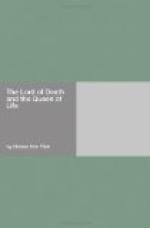Suddenly Jackson straightened up and looked about with a new interest. He went to one of the square doorways and very carefully removed the dust from a small plate on the lintel. He need not have been so careful; engraved in the solid metal was a single character, plainly in the same language as the other ideographs.
The architect smiled triumphantly into the inquiring eyes of his friends. “I won’t have to eat my hat,” said he. “This is a sure-enough city, all right, and this is its library!”
Smith was still busy on the little machine when they returned to the cube. He said that one part of it had disappeared, and was busily engaged in filing a bit of steel to take its place. As soon as it was ready, he thought, they could see what the apparatus meant.
The three had brought a large number of the reels. They were confident that a microscopic search of the ribbons would disclose something to bear out Jackson’s theory that the great structure was really a repository for books, or whatever corresponded with books on Mercury.
“But the main thing,” said the doctor, enthusiastically, “is to get over to the ‘twilight band.’ I’m beginning to have all sorts of wild hopes.”
Jackson urged that they first visit the big “mansion” on the outskirts of this place; he said he felt sure, somehow, that it would be worth while. But Van Emmon backed up the doctor, and the architect had to be content with an agreement to return in case their trip was futile.
Inside of a few minutes the cube was being drawn steadily over toward the left or western edge of the planet’s sunlit face. As it moved, all except Smith kept close watch on the ground below. They made out town after town, as well as separate buildings; and on the roads were to be seen a great many of those octagonal structures, all motionless.
After several hundred miles of this, the surface abruptly sloped toward what had clearly been the bed of an ocean. No sign of habitations here, however; so apparently the water had disappeared after the humans had gone.
This ancient sea ended a short distance from the district they were seeking. A little more travel brought them to a point where the sun cast as much shadow as light on the surface. It was here they descended, coming to rest on a sunlit knoll which overlooked a small, building-filled valley.
According to Kinney’s apparatus, there was about one-fortieth the amount of air that exists on the earth. Of water vapor there was a trace; but all their search revealed no human life. Not only that, but there was no trace of lower animals; there was not even a lizard, much less a bird. And even the most ancient-looking of the sculptures showed no creatures of the air; only huge, antediluvian monsters were ever depicted.




